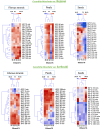Optimization of phenolic compound extraction from Tunisian squash by-products: A sustainable approach for antioxidant and antibacterial applications
- PMID: 40321154
- PMCID: PMC12048901
- DOI: 10.1515/biol-2025-1096
Optimization of phenolic compound extraction from Tunisian squash by-products: A sustainable approach for antioxidant and antibacterial applications
Abstract
The valorization of agricultural by-products is a key strategy for environmental sustainability. This study focuses on optimizing the extraction of phenolic compounds from by-products (peels, fibrous strands, and seeds) of two Tunisian squash landraces (e.g. Bejaoui and Karkoubi) using the response surface methodology to enhance their antioxidant and antibacterial properties. Ethanol concentration, extraction time, and temperature were the key parameters evaluated for their impact on phenolic compounds yield and bioactivity. High-performance liquid chromatography identified the major bioactive phenolic compounds, including vanillic acid, catechin gallate, hydroxytyrosol, and chlorogenic acid. The optimal extraction conditions for each by-product were defined as follows: Bejaoui peels (51.5% ethanol, 40.8°C, 50.5 min), fibrous strands (50.4% ethanol, 37.1°C, 36.3 min), and seeds (30% ethanol, 36.4°C, 8 min); Karkoubi peels (13.2% ethanol, 43.4°C, 47.2 min), fibrous strands (33.4% ethanol, 46.6°C, 10.8 min), and seeds (10.65% ethanol, 55.34°C, 23.16 min). The results demonstrated that optimizing extraction conditions may lead to significant enhancement of the total phenolic content and antiradical activity, with experimental values closely matching predictive models. Furthermore, the bioactive properties of these by-products, particularly their antibacterial activity, highlight their potential application as novel eco-friendly matrices for natural antioxidant and antimicrobial agents. This study underscores the importance of optimizing sustainable extraction techniques to maximize the valorization of agricultural waste, contributing to both environmental protection and the development of innovative natural products within the circular economy concept.
Keywords: Cucurbita maxima; antimicrobial activity; antioxidant activity; squash by-products; sustainable extraction; waste valorization.
© 2025 the author(s), published by De Gruyter.
Conflict of interest statement
Conflict of interest: Authors state no conflict of interest.
Figures



Similar articles
-
Sustainable Valorization of Coffee Silverskin Waste: Pressurized Liquid Extraction of Bioactive Compounds.Foods. 2025 Feb 12;14(4):615. doi: 10.3390/foods14040615. Foods. 2025. PMID: 40002059 Free PMC article.
-
Valorization of Pumpkin Peel as a Source of Bioactive Compounds: Optimization of Heat- and Ultrasound-Assisted Extraction.Molecules. 2023 Apr 2;28(7):3168. doi: 10.3390/molecules28073168. Molecules. 2023. PMID: 37049931 Free PMC article.
-
Valorization of Potato Peels (Solanum tuberosum) Using Infrared-Assisted Extraction: A Novel Sprouting Suppressant and Antibacterial Agent.Foods. 2024 Oct 28;13(21):3445. doi: 10.3390/foods13213445. Foods. 2024. PMID: 39517229 Free PMC article.
-
Valorisation of Agri-Food Waste for Bioactive Compounds: Recent Trends and Future Sustainable Challenges.Molecules. 2024 Apr 29;29(9):2055. doi: 10.3390/molecules29092055. Molecules. 2024. PMID: 38731546 Free PMC article. Review.
-
The Valorization of Potato Peels as a Functional Ingredient in the Food Industry: A Comprehensive Review.Foods. 2025 Apr 12;14(8):1333. doi: 10.3390/foods14081333. Foods. 2025. PMID: 40282735 Free PMC article. Review.
References
-
- Okasha M, Hegazy R, Kamel RM. Assessment of raisins byproducts for environmentally sustainable use and value addition. AgriEngineering. 2023;5(3):1469–80.
-
- Makahleh A, Saad B, Bari MF. Synthetic phenolics as antioxidants for food preservation. In Shahidi FBT-H of A for FP, editor. Woodhead Publishing Series in Food science, technology and nutrition. Cambridge, UK: Woodhead Publishing; 2015. p. 51–78. https://www.sciencedirect.com/science/article/pii/B9781782420897000038.
-
- Viana da Silva M, Santos MRC, Alves Silva IR, Macedo Viana EB, Dos Anjos DA, Santos IA, et al. Synthetic and Natural antioxidants used in the oxidative stability of edible oils: An overview. Food Rev Int. 2022;38(S1):349–72. 10.1080/87559129.2020.1869775. - DOI
LinkOut - more resources
Full Text Sources
